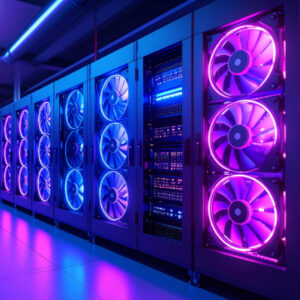Cooling Needs are a Hotter and Hotter Topic

Computers generate heat as they work, which is why laptops and desktops have fans and massive cloud computing server farms have equally massive climate control systems. Devices of any scale need to be properly cooled to maintain their functionality.
The problem is that we have numerous cloud-based resources available, and the cooling needs we’ve created have led to significant environmental and financial requirements.
It’s pretty bad, to be honest. If bundled with the countries of the world, the cloud would be one of the most insatiable consumers of electricity, and some estimates expect data centers to consume almost 10 percent of the United States’ annual electricity generation by 2030, with almost half that dedicated to preventing these servers—constantly running at full power and pumping out significant heat—from overheating.
The Environmental Impact is also Significant
All this hosted computing is primarily powered by electricity generated through the burning of fossil fuels, contributing to carbon dioxide emissions and exacerbating climate change. Additionally, the water-based cooling systems that most data centers rely on consume approximately 450,000 gallons of water per day, often straining local water sources that others also rely on. This is even more the case in arid areas that frequently see drought.
Finances Can Also Feel the Crunch
As you might imagine, these cooling systems are pretty expensive to maintain. Air cooling systems are simply not efficient enough to compensate for the heat generated by modern and high-density systems, particularly as AI becomes more prevalent. Liquid cooling and its efficiency are more expensive to procure, racking up costs in the millions for data centers that are then passed to the consumer.
New Technologies are Being Developed to Address These Issues
It isn’t all bad news, fortunately. New and more sustainable methods and technologies are being developed to address these cooling needs, which will ultimately help prolong the useful life of hardware and save some costs. For instance:
- Liquid immersion cooling – Some modern servers now operate completely submerged in non-conductive liquid, enjoying some significant heat dissipation efficiency and, in some cases, completely replacing air cooling.
- Direct-to-chip liquid cooling – Targeting the hottest components (like the CPU and GPU) with a direct application of liquid coolant helps move heat away more quickly.
- Free cooling – Ambient outdoor air temperatures can be utilized to cool data centers in a significantly more energy-efficient manner, particularly in cooler climates.
- Heat reuse – In a particularly innovative method, the excess heat that data centers produce can be captured and repurposed… for instance, heating buildings or greenhouses.
We’ll always be the first ones to acknowledge how important it is to recognize all the implications that any innovation brings about, and to help Indiana businesses manage these considerations.
If you are interested in learning more, give us a call today at 317-759-3972.
About the Author
Author’s recent posts
Download the
Business Owner’s Cybersecurity Blueprint


